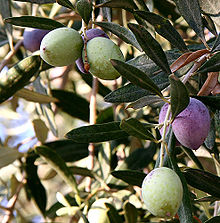**Etymology and History:**
– The word ‘olive’ comes from Latin ‘ŏlīva,’ possibly through Etruscan ‘eleiva’ from the archaic Proto-Greek form *ἐλαίϝα.
– The oldest Greek forms of the words are Mycenaean e-ra-wa and e-ra-wo or e-rai-wo.
– Fossil evidence indicates the olive tree originated around 20-40 million years ago in Italy and the eastern Mediterranean.
– Olives were first used by humans in Africa around 100,000 years ago for fuel and consumption.
– Olives were first cultivated 7,000 years ago in Mediterranean regions for lamp oil.
**Taxonomy and Cultivars:**
– There are six natural subspecies of Olea europaea, including europaea, cuspidata, cerasiformis, guanchica, laperrinei, and maroccana.
– Subspecies europaea has two varieties, europaea and silvestris.
– Wild-growing forms are sometimes treated as the species Olea oleaster.
– Hundreds of olive tree cultivars exist, impacting color, size, shape, and oil qualities.
– Many cultivars are self-sterile and planted in pairs for fertilization.
**Symbolic and Cultural Significance:**
– Olives were domesticated in the third millennium BC and were major exports in Minoan and Mycenaean periods.
– Olive oil was used for grooming and anointing in ancient Greece.
– The olive tree was sacred to Athena in Athenian myths.
– Olives have cultural and symbolic importance in Judaism, Christianity, Islam, Palestine, and ancient civilizations like Greece and Rome.
**Global Spread and Uses:**
– Olive tree cultivation spread globally, reaching South America, California, Japan, and India.
– Olive oil production is a significant industry, with Spain leading followed by Portugal, Italy, Tunisia, Greece, and Turkey.
– Olives are used for oil, eating, and various products like cosmetics and pharmaceuticals.
– The majority of olives are used for oil production and are an essential ingredient in Mediterranean cuisine.
**Notable Oldest Trees and Modern References:**
– Oldest known olive trees are found in Portugal, Montenegro, Croatia, Athens, Lebanon, and Jerusalem.
– The United States’ Great Seal depicts an eagle with an olive branch for peace.
– The United Nations’ flag features a world map with two olive branches.
– Olives have health benefits, with mentions in the Quran and use in Islamic traditions during Ramadan.
– In Palestine, olive trees symbolize resilience, community, and cultural identity, with harvest seasons celebrated as national holidays.
The olive, botanical name Olea europaea, meaning 'European olive', is a species of small tree or shrub in the family Oleaceae, found traditionally in the Mediterranean Basin. When in shrub form, it is known as Olea europaea 'Montra', dwarf olive, or little olive. The species is cultivated in all the countries of the Mediterranean, as well as in Australia, New Zealand, North and South America and South Africa. It is the type species for its genus, Olea. The tree and its fruit give their name to the Oleaceae plant family, which also includes species such as lilac, jasmine, forsythia, and the true ash tree.
| Olive Temporal range: Late Pleistocene to recent,
| |
|---|---|

| |
| Scientific classification | |
| Kingdom: | Plantae |
| Clade: | Tracheophytes |
| Clade: | Angiosperms |
| Clade: | Eudicots |
| Clade: | Asterids |
| Order: | Lamiales |
| Family: | Oleaceae |
| Genus: | Olea |
| Species: | O. europaea
|
| Binomial name | |
| Olea europaea | |

| |
| Distribution map of Olea europaea s.l. | |
The olive's fruit, also called an "olive", is of major agricultural importance in the Mediterranean region as the source of olive oil; it is one of the core ingredients in Middle Eastern and Mediterranean cuisines. Thousands of cultivars of the olive tree are known. Olive cultivars may be used primarily for oil, eating, or both. Olives cultivated for consumption are generally referred to as "table olives". About 80% of all harvested olives are turned into oil, while about 20% are used as table olives.

